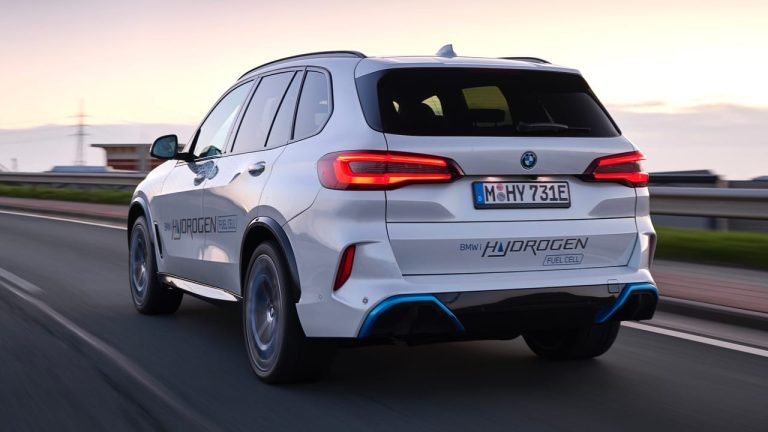
We look at the chemistry of water-emitting fuel-cell electric cars (FCEVs) and how the tech might save motoring as we know it
Published: 09 Sep 2024
What is a hydrogen car?
It's a car powered by hydrogen (yes, it's that simple, folks). Hydrogen has been spoken about as The Next Big Thing every year for too many decades now. And yet it still hasn't happened, but the fact it is the lightest and most explosive gas in the world might help explain why.
Engines need combustion, so it sounds both dangerous and perfect all at once. Tell me more about the upsides first.
Contrary to the lyrics of a popular '90s song that charted at No.1 for 15 (!) weeks, hydrogen is all around you. Being one of the key elements of water (H2O – with hydrogen present in duplicate), accessing this plentiful element is far easier than trying to drill for oil.
Advertisement – Page continues below
When it's burned it only emits water, so it's a dead certificate for carbon-neutral transportation. Plus you refuel just like you would with petrol – in a matter of minutes at a station.
Ok, what are the downsides?
Hydrogen isn't a new idea. Back in the 1920s, airships used hydrogen, but there were sadly dozens of fire-related fatalities. In the late 1930s, the Hindenburg disaster – still cited almost a century later – proved the final straw and put a stop to those awfully unsafe hydrogen blimps.
Oh dear. Presumably it's safe for land transport?
It can be. The hydrogen is stored in a high-pressure tank (or two) on the vehicle. Compressed hydrogen at 700 bar is equivalent to 10,153PSI (for context, you inflate your car's tires to about 33PSI) and if it leaks in any way, it's prone to spontaneously combust.
It's important to note that in hydrogen-powered vehicles, the hydrogen isn't used for combustion.
Advertisement – Page continues below
How does hydrogen work in a car then?
From its tank, the hydrogen is passed through an anode in a fuel cell. The anode has a catalyst – usually platinum – which forces the hydrogen to split into protons and electrons.
The protons get sucked across a 'proton exchange membrane' (PEM), while the electrons – unable to cross the PEM – get sent through a circuit, power the motor and come out the other end to combine with the oxygen in the air which has been passed through the cathode. H2 becomes H2O and kapow, planet-saving water vapor emissions.
It sounds a bit like a battery.
It's a bit like a battery. And just like a battery, it contains precious metals that aren't cheap to source or buy. And that's been the problem with hydrogen all these decades: the cost.
It's roughly about £1 million to install a hydrogen refueling station, which will split water molecules on-site. It also takes energy to split those atoms. Is that energy green? Not always.
Thank you for subscribing to our newsletter. Look out for your regular round-up of news, reviews and offers in your inbox.
Get all the latest news, reviews and exclusives, direct to your inbox.
And the alternative to not splitting those atoms on-site is to use tankers to transport hydrogen to the refueling stations, like petrol is now. There's a certain irony in a petrol truck moving 'greener' energy around the country.
Yeah, there is. So is there a way of keeping it safe in the fuel tanks, if it's not used for the spark?
Absolutely. Hydrogen power is already on our roads. It's been deployed in commercial vehicles, like buses, and it's better suited to heavy-goods trucks – some might even suggest hydrogen tankers, too – because hydrogen is far more energy dense (and crucially, more lightweight) than current and near-future actual battery chemistries.
Ah, batteries. Aren't they supposed to be the next big thing?
Those investing in them definitely want batteries to be, but battery-electric vehicles have their limitations too.
In addition to the energy density differences as mentioned, the infrastructure needed to make sure every household can charge at or near their home is nowhere near ready. Plus, there are some folks living in Rural Utopia that will never be able to access EV charging infrastructure easily – thus, finding an alternative would be useful.
Hmm…so what's the solution?
There's a number of carmakers that still think there's something in hydrogen development and fuel-cell electric vehicles (FCEVs). Recently BMW announced its plan to start selling a hydrogen-powered car from 2028, developing a platform in collaboration with Toyota.
Other companies are researching synthetic fuels, and BMW's board chair Oliver Zipse has already acknowledged that hydrogen is unlikely to go mainstream – at least for passenger cars. So chances are the nearer-term future is going to be a myriad of all these powertrains until technology enables some kind of earth-friendly silver-bullet solution… or, um, humans learn to fly/teleport*.
*delete as appropriate
